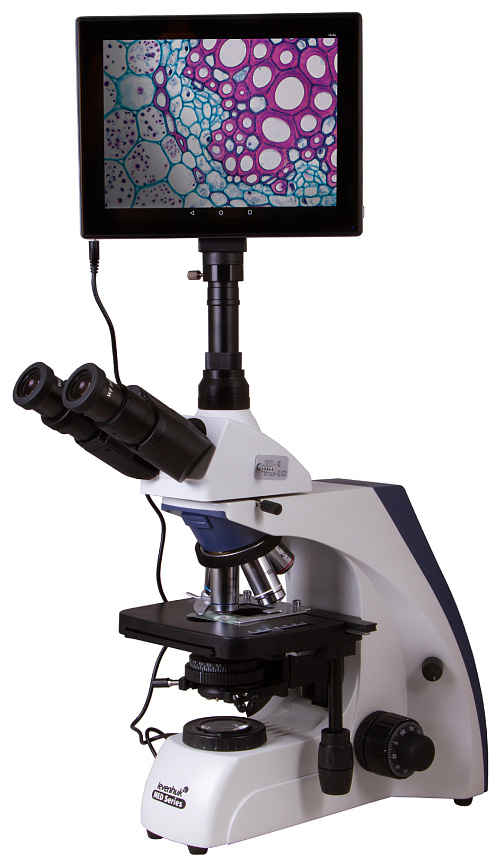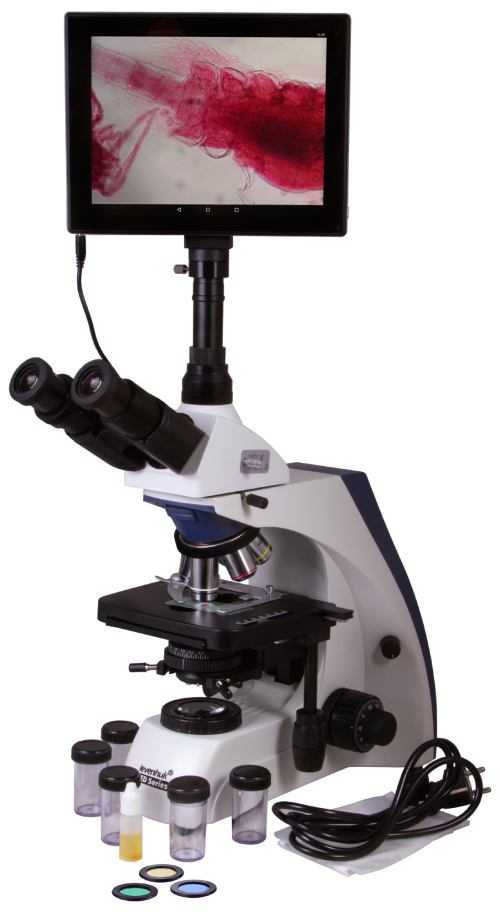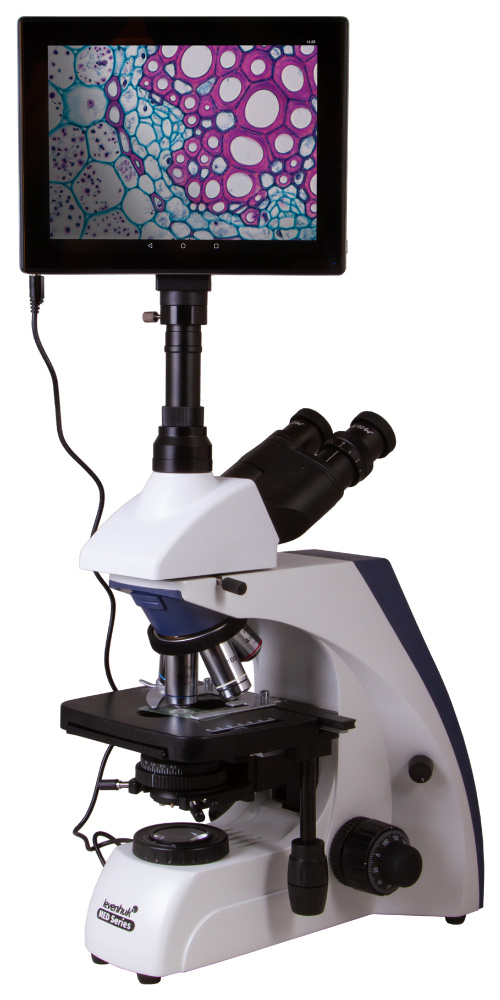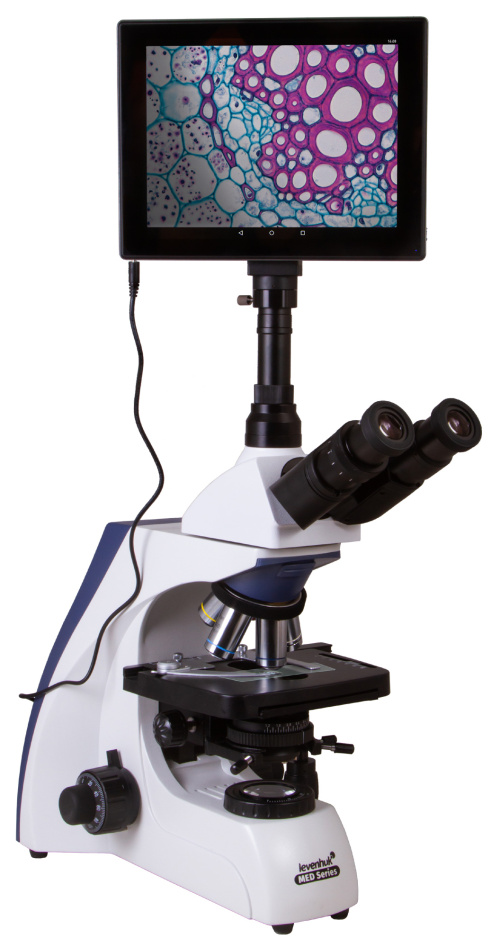Levenhuk MED D35T LCD Digital Trinocular Microscope
Magnification: 40–1000x. Trinocular head, 5MP digital camera with an LCD screen, infinity-corrected semi-plan achromatic objective lenses, an Abbe condenser with an iris diaphragm
| Product ID | 74003 |
| Brand | Levenhuk, Inc., USA |
| Warranty | lifetime |
| EAN | 5905555005058 |
| Package size (LxWxH) | 61x45x28 |
| Shipping Weight | 11.74 |
The Levenhuk MED D35T LCD Trinocular Digital Microscope is designed for professional micro-investigations in medicine, biochemistry, classical biology, and other scientific fields. It is perfect for a clinical diagnostic laboratory or university department. The microscope comes with a digital camera with an LCD screen, allows for setting up Köhler illumination and supports oil immersion. The microscope uses plan achromatic optics, which allow for observing at magnifications of 40x to 1000x.
Plan achromatic infinity-corrected optics
The microscopes in the Levenhuk MED 35 series are equipped with an infinity-corrected optical system that is used in professional and high-class microscopes. This system includes Infinity PlanAchromat objectives and allows for obtaining clear, high contrast images with high level of flatness.
One of the most important features of an infinity-corrected optical system is that it allows for installing any additional parts in the optical path between objective lenses and an ocular tube. The additional parts include polarizers and epi-fluorescence light. All in all, modular design and simple operation make Levenhuk MED 35 optimal microscopes for using in different kinds of microscopy and working in hematological, histological, microbiological, and other laboratories.
A rotatable head with a beam splitter
The trinocular head with a beam splitter consists of a binocular visual unit and a vertical tube for installing a digital camera in it. The kit includes two 10x wide-field eyepieces with diopter adjustment, which are used for visual observations, and a 5MP digital camera. A camera transmits an image to a built-in LCD screen in a real time mode. That makes work in a laboratory easier and more practical as well as reduces eyestrain and tension in the rotator cuff, as there is no necessity to look through the eyepieces. An LCD screen is used for setting up all of the camera options (choosing recording modes, storage spaces, etc.) and image processing, and connecting to a computer is not necessary.
Digital capabilities
The digital camera allows for shooting videos and photos in high resolution. The camera also allows for connecting additional equipment (a keyboard, a mouse, headphones, external monitor or TV), supports memory cards and other data storage. The software allows for adjusting size, image brightness and contrast, exposure time and white balance, calibrating a camera and objective lenses, measuring specimens or structures (several measurement units are available). In addition, the program allows for carrying out a particle analysis.
Optical glass with an anti-fungal coating
A revolving nosepiece allows for installing up to five objective lenses. The kit includes infinity-corrected plan achromatic objectives of various magnifications. The optics eliminate chromatic aberrations, create a flat field of view, and enhance color rendering. Objective lenses with higher magnification are equipped with spring-loaded frames; the 100x objective can be used for oil immersion. Coarse and fine focusing are available.
Convenient work with microscope slides
The specimens are fixed on a stage, which is equipped with a mechanical scale. The stage is moveable along two axes. Under a stage, there is an illumination unit that consists of a halogen light with brightness adjustment. There is also an Abbe condenser, which is equipped with an iris diaphragm. The light is powered by an AC power supply.
Features:
- Magnification: 40x to 1000x
- Trinocular head with a beam splitter, wide-field eyepieces
- Plan achromatic optics with an anti-fungal coating
- Halogen light with adjustable brightness
- Setting up Köhler illumination is available
- Powered by an AC power supply
- The kit includes a 5MP digital camera with an Android-based LCD screen
The kit includes:
- Microscope base with a stand
- 360° rotatable trinocular head
- Infinity-corrected plan achromatic objective lenses: 4x, 10x, 40xs, 60xs, 100xs (oil) with an anti-fungal coating
- Wide-field eyepieces: WF10x/22mm with an anti-fungal coating (2 pcs)
- Abbe condenser N.A. 1.25 with an iris diaphragm
- Filters: blue, green, yellow
- Bottle of immersion oil
- Fuse (2 pcs)
- Power cord for microscope
- Dust cover
- 5MP digital camera with an LCD screen
- Power cord for camera
- User manual and lifetime warranty
Caution:
Please refer to the specifications table for the correct mains voltage and never attempt to plug a 110V device into 220V outlet and vice versa without using a converter. Remember that mains voltage in the U.S. and Canada is 110V and 220–240V in most European countries.
Some things you can see under a microscope:





Levenhuk MED D35T LCD Digital Trinocular Microscope is also compatible with other Levenhuk digital cameras (additional cameras are purchased separately). Levenhuk cameras are installed in the eyepiece tube instead of an eyepiece. This microscope is also compatible with any other digital microscope cameras.
| Product ID | 74003 |
| Brand | Levenhuk, Inc., USA |
| Warranty | lifetime |
| EAN | 5905555005058 |
| Package size (LxWxH) | 61x45x28 |
| Shipping Weight | 11.74 |
| Type | biological, light/optical, digital |
| Head | trinocular |
| Optics material | optical glass with anti-fungal coating |
| Nozzle | 360 ° rotatable, with switching (dividing) luminous flux |
| Head inclination angle | 30 ° |
| Magnification, x | 40 — 1000 |
| Eyepiece tube diameter, mm | 30mm (binocular head), 23.2 mm (third vertical tube) |
| Eyepieces | WF10x/22mm, wide-field with diopter adjustment (2 pcs.) |
| Objectives | infinity-corrected plan achromatic objective lenses: 4x, 10x, 40xs, 60xs, 100xs (oil) |
| Revolving nosepiece | for 5 objectives |
| Interpupillary distance, mm | 48 — 75 |
| Stage, mm | 180x160 |
| Stage moving range, mm | 80/50 |
| Stage features | mechanical double-layer |
| Eyepiece diopter adjustment, diopters | ±5 |
| Condenser | Abbe N. A. 1.25 with an iris diaphragm |
| Diaphragm | iris |
| Focus | coaxial, coarse (0.5 mm) and fine (0.002 mm), with rack and pinion |
| Body | metal |
| Illumination | halogen |
| Brightness adjustment | ✓ |
| Power supply | 100–240V |
| Light source type | 12V/30W, 85–230V AC |
| Light filters | blue, green, yellow |
| Additional | collector lens, Köhler illumination |
| Special features | LCD screen 9.4 inch, color, sensor; built-in memory: 4GB |
| Ability to connect additional equipment | support of microSD cards with capacity up to 32Gb; monitor/TV (with HDMI port); a flash drive, a mouse, a keyboard (with a USB connector); headphones (3.5mm) |
| User level | experienced users, professionals |
| Assembly and installation difficulty level | complicated |
| Application | laboratory/medical |
| Illumination location | lower |
| Research method | bright field |
| Pouch/case/bag in set | dust cover |
| Maximum resolution | 2048x1536 |
| Megapixels | 5 |
| Sensor element | 1/2.5" |
| Pixel size, μm | 2.2x2.2 |
| Video recording | yes |
| Image format | *.jpg |
| Video format | 1080p, *.3gp |
| White balance | manual, automatic |
| Exposure control | manual, automatic |
| Sensitivity, V/lux-sec@550nm | 0.53 |
| Frame rate | 15 frames per second |
| Usage location | the third 23.2mm ocular tube of the microscope |
| Software, drivers | Android 5.1 (multilingual) |
| Programmable options | measurement, brightness, particle analysis, etc. |
| Output | USB 2.0 (2 pcs), mini HDMI, Wi-Fi, TF memory card slot |
| Camera power supply | DC 12V/2A, via AC adapter |
We have gathered answers to the most frequently asked questions to help you sort things out
Find out why studying eyes under a microscope is entertaining; how insects’ and arachnids’ eyes differ and what the best way is to observe such an interesting specimen
Read this review to learn how to observe human hair, what different hair looks like under a microscope and what magnification is required for observations
Learn what a numerical aperture is and how to choose a suitable objective lens for your microscope here
Learn what a spider looks like under microscope, when the best time is to take photos of it, how to study it properly at magnification and more interesting facts about observing insects and arachnids
This review for beginner explorers of the micro world introduces you to the optical, illuminating and mechanical parts of a microscope and their functions
Short article about Paramecium caudatum - a microorganism that is interesting to observe through any microscope

























